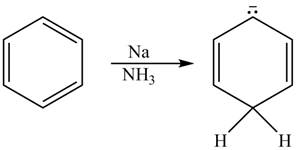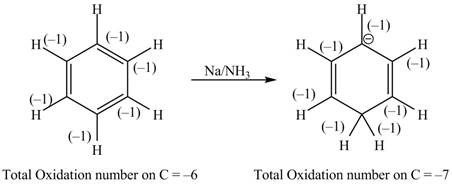
(a)
Interpretation:
The reaction,
Concept introduction:
A redox reaction is a type of reaction in which one reacting species gets oxidize and other reacting species is reduced. The exchange of electron takes place between the reacting species. Water molecules and protons can be used to
Answer to Problem 10.26P
The reaction,
Explanation of Solution
The given reaction is shown below.
The reactant and products with an oxidation number of atoms are shown below.

Figure 1
The oxidation number of reactant is lower than the oxidation number of the product. Therefore, the reaction is an oxidation reaction.
The number of electrons transfer in the reaction is given by the expression as shown below.
Where,
•
•
Substitute the values of
Therefore, the number of electrons transferred in the reaction is
The number of electrons transferred in the oxidation reaction is
(b)
Interpretation:
The given reaction is to be classified as an oxidation, a reduction, or neither. The number of electrons transferred in the reaction is to be stated when the corresponding reaction is oxidation or reduction.
Concept introduction:
A redox reaction is a type of reaction in which one reacting species gets oxidize and other reacting species is reduced. The exchange of electron takes place between the reacting species. Water molecules and protons can be used to balance a redox
Answer to Problem 10.26P
The given reaction is classified as oxidation reaction. The number of electrons transferred in the reaction is
Explanation of Solution
The given reaction is shown below.

Figure 2
The reactant and products with oxidation number of atoms are shown below.

Figure 3
The oxidation number of reactant is lower than the oxidation number of the product. Therefore, the reaction is an oxidation reaction.
The number of electrons transfer in the reaction is given by the expression as shown below.
Where,
•
•
Substitute the values of
Therefore, the number of electrons transferred in the reaction is
The number of electrons transferred in the oxidation reaction is
(c)
Interpretation:
The reaction,
Concept introduction:
A redox reaction is a type of reaction in which one reacting species gets oxidize and other reacting species is reduced. The exchange of electron takes place between the reacting species. Water molecules and protons can be used to balance a redox chemical reaction in the acidic medium.
Answer to Problem 10.26P
The reaction,
Explanation of Solution
The given reaction is shown below.
The reactant and products with oxidation number of atoms are shown below.

Figure 4
The oxidation number of reactant is higher than the oxidation number of the product. Therefore, the reaction is the reduction reaction.
The number of electrons transfer in the reaction is given by the expression as shown below.
Where,
•
•
Substitute the values of
Therefore, the number of electrons transferred in the reaction is
The number of electrons transferred in the reduction reaction is
(d)
Interpretation:
The given reaction is to be classified as an oxidation, a reduction, or neither. The number of electrons transferred in the reaction is to be stated when the corresponding reaction is oxidation or reduction.
Concept introduction:
A redox reaction is a type of reaction in which one reacting species gets oxidize and other reacting species is reduced. The exchange of electron takes place between the reacting species. Water molecules and protons can be used to balance a redox chemical reaction in the acidic medium.
Answer to Problem 10.26P
The given reaction is to be classified as oxidation reaction. The number of electrons transferred in the reaction is
Explanation of Solution
The given reaction is shown below.

Figure 5
The reactant and products with oxidation number of atoms are shown below.

Figure 6
The oxidation number of reactant is lower than the oxidation number of the product. Therefore, the reaction is an oxidation reaction.
The number of electrons transfer in the reaction is given by the expression as shown below.
Where,
•
•
Substitute the values of
Therefore, the number of electrons transferred in the reaction is
The number of electrons transferred in the oxidation reaction is
(e)
Interpretation:
The given reaction is to be classified as an oxidation, a reduction, or neither. The number of electrons transferred in the reaction is to be stated when the corresponding reaction is oxidation or reduction.
Concept introduction:
A redox reaction is a type of reaction in which one reacting species gets oxidize and other reacting species is reduced. The exchange of electron takes place between the reacting species. Water molecules and protons can be used to balance a redox chemical reaction in the acidic medium.
Answer to Problem 10.26P
The given reaction is to be classified as oxidation reaction. The number of electrons transferred in the reaction is
Explanation of Solution
The given reaction is shown below.

Figure 7
The reactant and products with oxidation number of atoms are shown below.

Figure 8
The oxidation number of reactant is lower than the oxidation number of product. Therefore, the reaction is oxidation reaction.
The number of electrons transfer in the reaction is given by the expression as shown below.
Where,
•
•
Substitute the values of
Therefore, the number of electrons transferred in the reaction is
The number of electrons transferred in the oxidation reaction is
(f)
Interpretation:
The given reaction is to be classified as an oxidation, a reduction, or neither. The number of electrons transferred in the reaction is to be stated when the corresponding reaction is oxidation or reduction.
Concept introduction:
A redox reaction is a type of reaction in which one reacting species gets oxidize and other reacting species is reduced. The exchange of electron takes place between the reacting species. Water molecules and protons can be used to balance a redox chemical reaction in the acidic medium.
Answer to Problem 10.26P
The given reaction is to be classified as neither
Explanation of Solution
The given reaction is shown below.

Figure 9
The reactant and products with an oxidation number of atoms are shown below.

Figure 10
The oxidation number of reactant is equal to the oxidation number of the product. Therefore, the reaction is neither oxidation reaction nor reduction reaction.
The compound neither oxidized nor reduced.
(g)
Interpretation:
The given reaction is to be classified as an oxidation, a reduction, or neither. The number of electrons transferred in the reaction is to be stated when the corresponding reaction is oxidation or reduction.
Concept introduction:
A redox reaction is a type of reaction in which one reacting species gets oxidize and other reacting species is reduced. The exchange of electron takes place between the reacting species. Water molecules and protons can be used to balance a redox chemical reaction in the acidic medium.
Answer to Problem 10.26P
The given reaction is to be classified as a reduction reaction. The number of electrons transferred in the reaction is
Explanation of Solution
The given reaction is shown below.

Figure 11
The reactant and products with oxidation number of atoms are shown below.
\
Figure 12
The oxidation number of reactant is higher than the oxidation number of the product. Therefore, the reaction is reduction reaction.
The number of electrons transfer in the reaction is given by the expression as shown below.
Where,
•
•
Substitute the values of
Therefore, the number of electrons transferred in the reaction is
The number of electrons transferred in the reduction reaction is
Want to see more full solutions like this?
Chapter 10 Solutions
Organic Chemistry, Ebook And Single-course Homework Access
- draw the enolate anion and the carbonyl that would be needed to make this product through an aldol addition reaction.arrow_forwardDraw the Michael Adduct and the final product of the Robinson annulation reaction. Ignore inorganic byproducts.arrow_forwardDraw the Michael adduct and final product of the Robinson annulation reaction. Ignore inorganic byproductsarrow_forward
- Post Lab Questions. 1) Draw the mechanism of your Diels-Alder cycloaddition. 2) Only one isomer of product is formed in the Diels-Alder cycloaddition. Why? 3) Imagine that you used isoprene as diene - in that case you don't have to worry about assigning endo vs exo. Draw the "endo" and "exo" products of the Diels-Alder reaction between isoprene and maleic anhydride, and explain why the distinction is irrelevant here. 4) This does not hold for other dienes. Draw the exo and endo products of the reaction of cyclohexadiene with maleic anhydride. Make sure you label your answers properly as endo or exo. 100 °C Xylenes ??? 5) Calculate the process mass intensity for your specific reaction (make sure to use your actual amounts of reagent).arrow_forwardIndicate the product(s) A, B C and D that are formed in the reaction: H + NH-NH-CH [A+B] [C+D] hydrazonesarrow_forwardHow can you prepare a 6 mL solution of 6% H2O2, if we have a bottle of 30% H2O2?arrow_forward
- How many mL of H2O2 from the 30% bottle must be collected to prepare 6 mL of 6% H2O2.arrow_forwardIndicate the product(s) B and C that are formed in the reaction: HN' OCH HC1 B + mayoritario C minoritario OCH3arrow_forwardIndicate the product(s) that are formed in the reaction: NH-NH, OCH3 -H₂O OCH3arrow_forward
- 21.38 Arrange the molecules in each set in order of increasing acidity (from least acidic to most acidic). OH OH SH NH2 8 NH3 OH (b) OH OH OH (c) & & & CH3 NO2 21.39 Explain the trends in the acidity of phenol and the monofluoro derivatives of phenol. OH OH OH OH PK 10.0 PK 8.81 PK 9.28 PK 9.81arrow_forwardidentify which spectrum is for acetaminophen and which is for phenacetinarrow_forwardThe Concept of Aromaticity 21.15 State the number of 2p orbital electrons in each molecule or ion. (a) (b) (e) (f) (c) (d) (h) (i) DA (k) 21.16 Which of the molecules and ions given in Problem 21.15 are aromatic according to the Hückel criteria? Which, if planar, would be antiaromatic? 21.17 Which of the following structures are considered aromatic according to the Hückel criteria? ---0-0 (a) (b) (c) (d) (e) (h) H -H .8.0- 21.18 Which of the molecules and ions from Problem 21.17 have electrons donated by a heteroatom?arrow_forward
 Chemistry: The Molecular ScienceChemistryISBN:9781285199047Author:John W. Moore, Conrad L. StanitskiPublisher:Cengage Learning
Chemistry: The Molecular ScienceChemistryISBN:9781285199047Author:John W. Moore, Conrad L. StanitskiPublisher:Cengage Learning General Chemistry - Standalone book (MindTap Cour...ChemistryISBN:9781305580343Author:Steven D. Gammon, Ebbing, Darrell Ebbing, Steven D., Darrell; Gammon, Darrell Ebbing; Steven D. Gammon, Darrell D.; Gammon, Ebbing; Steven D. Gammon; DarrellPublisher:Cengage Learning
General Chemistry - Standalone book (MindTap Cour...ChemistryISBN:9781305580343Author:Steven D. Gammon, Ebbing, Darrell Ebbing, Steven D., Darrell; Gammon, Darrell Ebbing; Steven D. Gammon, Darrell D.; Gammon, Ebbing; Steven D. Gammon; DarrellPublisher:Cengage Learning

